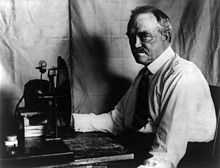Charles Francis Jenkins
| Charles Francis Jenkins | |
|---|---|
 | |
| Born |
August 22, 1867 Dayton, Ohio |
| Died |
June 6, 1934 (age 66) Washington, D.C. |
| Nationality | American |
| Education | none |
|
Engineering career | |
| Significant projects | Over 400 patents related to a variety of inventions |
| Significant advance | Motion picture projector and television |
| Significant awards |
Elliott Cresson Medal (1897) John Scott Medal (1913) |
Charles Francis Jenkins (August 22, 1867 – June 6, 1934) was an American pioneer of early cinema and one of the inventors of television, though he used mechanical rather than electronic technologies. His businesses included Charles Jenkins Laboratories and Jenkins Television Corporation (the corporation being founded in 1928, the year the Laboratories were granted the first commercial television license in the United States). Over 400 patents were issued to Jenkins, many for his inventions related to motion pictures and television .
Jenkins was born in Dayton, Ohio, grew up near Richmond, Indiana, where he went to school, and went to Washington, D.C. in 1890, where he worked as a stenographer.
Motion pictures
He started experimenting with movie film in 1891, and eventually quit his job and concentrated fully on the development of his own movie projector, the Phantoscope.
As the Richmond Telegram reported, on June 6, 1894,[1] Jenkins visited Richmond to show his parents, friends and newsmen a gadget he had been working on for two years: a "motion picture projecting box". They gathered at Jenkins' cousin's jewelry store in downtown Richmond and viewed the first film projected in front of an audience. The motion picture was of a vaudeville dancer doing a butterfly dance, which Jenkins had filmed himself in the backyard of his Washington boarding house. Not only was this the first showing of a reeled film with electric light before an audience, but it was also the first motion picture with color. Each frame was painstakingly colored by hand.
At the Bliss Electrical School, in Washington, D.C., he met his classmate Thomas Armat, and together they improved the design. They did a public screening at the Cotton States and International Exposition in Atlanta in 1895 and subsequently broke up quarreling over patent issues. This modified Phantoscope of Jenkins and Armat was patented July 20, 1897. Jenkins eventually sold his interest in the projector to Armat. Armat subsequently sold the rights to Thomas Edison, who marketed the projector under the name Vitascope. It was with this projector that Edison began public showings in vaudeville theaters of filmed motion pictures, with paid admission.
Jenkins married Grace Love, the daughter and descendant of an old established Maryland family, in 1902. Ms. Love was the sister-in-law of the prominent Washington, D.C. developer, L.E. Breuninger.
Television
Jenkins moved on to work on television. He published an article on "Motion Pictures by Wireless" in 1913, but it was not until 1923 that he transmitted moving silhouette images for witnesses, and it was June 13, 1925 that he publicly demonstrated synchronized transmission of pictures and sound. He was granted the U.S. patent No. 1,544,156 (Transmitting Pictures over Wireless) on June 30, 1925 (filed on March 13, 1922).
His mechanical technologies (also pioneered by John Logie Baird) were later overtaken by electronic television such as devised by Vladimir Zworykin and Philo Farnsworth.
In 1928, the Jenkins Television Corporation opened the first television broadcasting station in the U.S., named W3XK, which went on air on July 2 and first sent from the Jenkins Labs in Washington and from 1929 on from Wheaton, Maryland, five nights a week. At first, the station could only send silhouette images due to its narrow bandwidth, but that was soon rectified and real black-and-white images were transmitted.
In March 1932, Jenkins Television Corporation was liquidated and its assets acquired by Lee DeForest Radio Corporation. Within months, the DeForest company went bankrupt and the assets were bought by RCA stopping all work on electromechanical television.
Achievements, awards
Jenkins was awarded the prestigious Elliott Cresson Gold Medal for scientific achievement in 1897 and the Scott Medal in 1913 by the Franklin Institute & Science Museum-Philadelphia.
He was the founder and first president of the Society of Motion Picture Engineers (now includes television, SMPTE).[2]
Jenkins wrote several books including Vision By Radio, Radio Photographs, Radio Photograms and The Boyhood of an Inventor, as well as many articles that focused on his inventions, which were published in a variety of national magazines.
He received an honorary doctor of science degree from Earlham College, Richmond, Indiana, his alma mater.
The Academy of Television Arts & Sciences, best known for the annual Emmy Awards, commemorates the contributions of Jenkins to the television industry by naming one of the academy’s most prestigious awards after him: the Charles F. Jenkins Lifetime Achievement Award is a special engineering honor to an individual whose contributions over time have significantly affected the state of television technology and engineering.
Jenkins was inducted into the National Inventors Hall of Fame in 2011.
Charles Francis Jenkins died at age 66 in Washington, D.C. He is interred in Rock Creek Cemetery.
References
- ↑ Details/documentation on first projection of a filmed motion picture before an audience.
- ↑ Graham, Gerald G. (1989). "3". Canadian film technology, 1896-1986. University of Delaware Press. pp. 41–43. ISBN 0-87413-347-5.
External links
- Charles Francis Jenkins at the Internet Movie Database
- Case Files from the Franklin Institute on Jenkins's Phantoscope
- Biography emphasizing his movie projector development.
- Biography emphasizing his television endeavours.
- W3XK
- Various biographic excerpts
- Some images
- Jenkins marriage
- Charles Francis Jenkins at Find a Grave
|